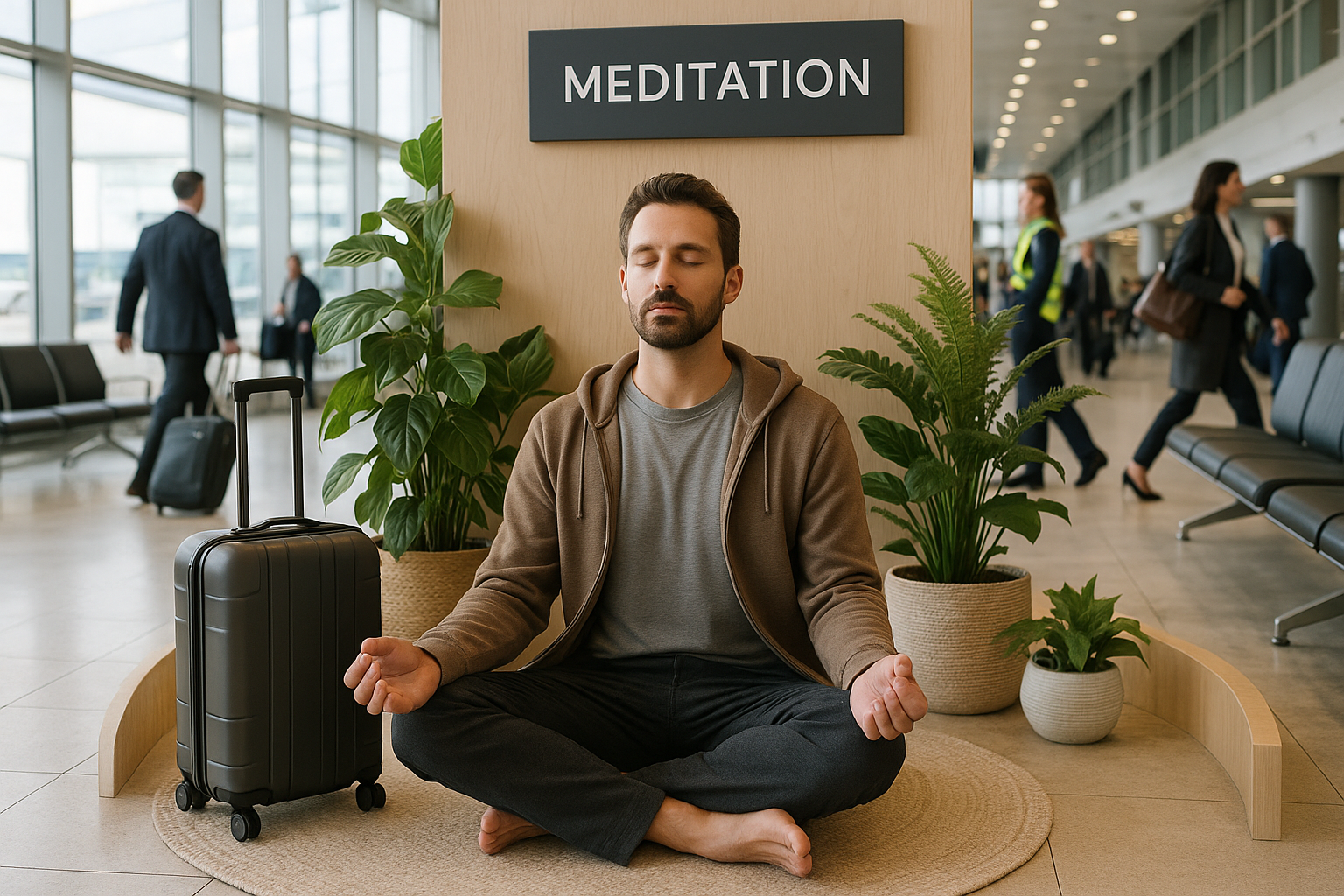You check your watch—another two hours until your flight. The crowded, chaotic environment feels overwhelming. But what if I told you there’s a way to escape the stress and bring a sense of tranquillity to your journey? Welcome to the world of mobile meditation, a tool for inner peace amidst the hubbub of airports and stress-free layovers.
But why would a busy traveler need meditation, especially in transit? Airports, flights, and layovers can be a stress-inducing experience. The combination of tight schedules, security checks, and unexpected delays can push even the most seasoned traveler to the brink. But with a proper understanding of meditation and its applicability in transit, these stressful situations can become opportunities for achieving inner calm and enhancing our overall wellbeing.
Understanding Meditation in Transit
Meditation in transit—or as we like to call it, “Zen on the Go”—is not about sitting cross-legged in the middle of a crowded terminal. It’s about using the tools and techniques of meditation to cultivate mindfulness, a mental state where you’re fully present and engaged in the current moment. This practice can transform mundane or stressful travel experiences into opportunities for serenity and personal growth.
When we talk about ‘Zen on the Go,’ we’re not just referring to traditional meditation practices. Rather, we’re broadening the definition to include a variety of mindful activities that can be done anywhere, anytime, regardless of external circumstances. Whether it’s conscious breathing, guided visualizations, or simple mindfulness exercises, these practices can bring about a profound change in our perspective towards travel and its associated stressors.
A Glimpse into the Article
In this comprehensive guide, we will delve into the world of mobile meditation, exploring the concept of ‘Zen on the Go’ in detail. We will discuss the rationale behind meditating in transit, the benefits it offers, and practical strategies for incorporating mindfulness into your travel routine.
We will begin by examining the roots of meditation and its evolution into a universally recognized stress-management tool. We’ll explore how these ancient techniques can be adapted to modern life, particularly within the context of travel. We’ll also address common misconceptions about meditation, such as the belief that it requires complete silence or a specific posture, and how these can be overcome for effective practice in transit.
Next, we will explore the tangible benefits of meditating in transit. We’ll delve into scientific research that highlights the positive impacts of mindfulness on stress levels, cognitive function, and overall well-being. We’ll also share personal stories from individuals who have found solace in their travel journeys through meditation.
Lastly, we will provide a step-by-step guide on how to incorporate ‘Zen on the Go’ into your travel routine. We’ll discuss different meditation techniques, offer tips for dealing with common travel stressors, and provide resources for guided meditations and apps to support your practice. Whether you’re a seasoned meditator or a curious beginner, you’ll find valuable insights to enhance your travel experience and overall quality of life.
Get ready to embark on a journey of inner peace and tranquillity, even amidst the chaos of travel. Welcome to ‘Zen on the Go’.
Introduction to Meditating in Transit
Traveling can be a stress-inducing experience. Whether you’re rushing through the airport to catch a flight, enduring a long layover, or dealing with unexpected delays, it’s easy to become overwhelmed. However, meditation can provide a valuable tool for staying calm and collected throughout your journey. This practice, often associated with tranquility and mindfulness, can be done anywhere, making it perfect for those on the go.
When performed regularly, meditation can offer numerous benefits, such as reduced stress, improved concentration, and a greater sense of peace and well-being. More importantly, it doesn’t require any special equipment or locations – just a few minutes of your time. The concept of “Zen on the Go” leverages this accessibility of meditation, enabling you to find peace in the chaos of travel.
To understand how you can effectively incorporate meditation into your travel plans, it’s important to grasp its fundamental principles, techniques, and benefits. This article will guide you through the process of meditating in transit, allowing you to experience peaceful airports and stress-free layovers. For a visual guide on meditating in transit, consider watching “Meditation for Traveling” by The Honest Guys on YouTube.
Understanding the Basics of Meditation
Meditation is a practice where an individual uses a technique – such as mindfulness, or focusing their mind on a particular object, thought or activity – to train attention and awareness, and achieve a mentally clear and emotionally calm and stable state. These techniques vary greatly, but all aim at achieving a sense of inner peace.
The first step in meditating is to find a quiet location, free from distractions. This can be challenging in busy airports or during layovers, but not impossible. You could use noise-cancelling headphones, or even just close your eyes and focus inward. You don’t need a specific posture for meditation – it’s more about comfort and focus. So whether you’re seated, lying down, or even walking, you can meditate.
The next step is to choose a focus for your meditation. This could be your breath, a mantra, or even the sensations in your body. By maintaining your focus on this single point, you can gradually draw your attention away from the external environment and into a more peaceful internal state. For a more detailed look at meditation techniques, watch “Meditation Techniques for Travel” by Headspace on YouTube.
Applying Meditation Techniques in Transit
Applying meditation techniques during travel is similar to meditating at home, with a few adaptations for the unique challenges presented by transit environments. The first challenge is finding a suitable location. Ideally, you want to find a quiet, comfortable spot where you won’t be disturbed. However, when you’re in a crowded airport or on a busy plane, this isn’t always possible. One solution is to use headphones to block out external noise, allowing you to focus on your meditation.
Another challenge is dealing with interruptions. During a layover, you might need to check the departure boards, respond to messages, or deal with other distractions. One approach to handle this is by practicing “mindful moments” – brief periods of mindfulness that you can slot in throughout your day. These can be as short as one minute, but can still provide a powerful reset for your mind.
The final challenge is maintaining your meditation practice amidst the unpredictability of travel. Flights can be delayed, plans can change, and stress can mount. However, by maintaining a flexible approach to your meditation – fitting it in when you can, rather than sticking to a rigid schedule – you can help to cultivate a sense of calm and resilience that carries you through these challenges. Take a look at the table below for a comparison of various meditation techniques and their applicability in transit:
| Meditation Technique | Description | Applicability in Transit |
|---|---|---|
| Mindfulness | Focus on the present moment without judgment | High – can be done anywhere, anytime |
| Body scan | Focus on sensations in different parts of the body | Medium – best done in a seated or lying position |
| Walking meditation | Focus on the physical act of walking | Low – challenging in crowded environments |
Beneficial Effects of Meditating in Transit
Meditating in transit can have numerous benefits, both for your travel experience and for your overall well-being. The primary benefit is stress reduction. Travel, particularly air travel, can be fraught with stressors, from the rush to make your flight, to the unpredictability of delays, to the cramped conditions on the plane. By cultivating a sense of inner calm through meditation, you can help to mitigate these stressors and improve your travel experience.
A secondary benefit is improved focus and awareness. Travel often involves juggling numerous tasks and details, which can be overwhelming. Through the practice of mindfulness in meditation, you can improve your ability to stay present and focused, rather than getting lost in worries about the future or the past.
Finally, meditating in transit can contribute to a more positive travel experience. By taking the time to pause and center yourself amidst the chaos of travel, you can cultivate a more relaxed, patient, and open-minded attitude. This can enhance your ability to deal with challenges, engage with new experiences, and truly enjoy your journey. For more insights into the benefits of meditation while traveling, consider watching “The Benefits of Meditation for Travelers” by Calm on YouTube.

Conclusion
In the course of this article, we’ve delved deep into the intricate world of software engineering, with a particular emphasis on certain technical aspects such as application development, code optimization, and bug fixing, to name a few. We’ve taken the dense, sometimes perplexing language of IT and engineering, and translated it into digestible, understandable pieces, taking care not to dilute the intensity of the topic at hand.
Reflecting on the key points that we’ve covered, we started with a broad overview of software engineering, breaking down its complex components into their simplest forms. We then moved on to the more technical parts, introducing the reader to the world of code languages, databases, and algorithms, and demonstrating the critical role they play in the software development process. We also underscored the importance of optimization and efficiency in coding and how these can drastically impact the functionality and speed of an application.
In the latter part of the article, we addressed the inevitable issue of bugs and errors in software development. We discussed various strategies and approaches to bug fixing, emphasizing the importance of a systematic, thorough approach to testing and debugging. Here, the importance of ongoing learning and skill development for software engineers was also highlighted, as the technological landscape is constantly changing and evolving.
The realm of software engineering is vast and complex, and this article was but a brief tour of its various aspects. However, our aim was not to provide an exhaustive account, but rather to foster an understanding and appreciation of the field, its challenges, and its triumphs.
This exploration is testament to the fact that software engineering is not just about writing code; it’s about problem-solving, innovation, and creativity. It is a field that is both demanding and rewarding, requiring a blend of technical acumen, logical thinking, and imaginative vision.
To anyone seeking to delve deeper into this fascinating world, we encourage you to read more, learn more, and explore more. The Computer Society’s Technical Committee on Software Engineering is an excellent resource for anyone interested in software engineering.
As we wrap up, we would love to hear your thoughts and experiences. How have you navigated the complexities of software engineering? What strategies have you found most effective in dealing with coding challenges or bugs? Feel free to share your insights in the comments section below, or connect with us on our social media channels.
And finally, if you found this article informative and helpful, we encourage you to share it with your colleagues, friends, or anyone else who might benefit from it. By doing so, you will not only be spreading valuable knowledge, but you will also be contributing to the growth and development of the software engineering community.
In conclusion, we reiterate that software engineering, with all its complexities and intricacies, is an incredibly rewarding field, offering countless opportunities for learning, growth, and innovation. Whether you’re a seasoned professional or a budding enthusiast, we hope this article has deepened your understanding and sparked your interest in this dynamic field.
Remember, in the world of software engineering, the journey is just as important as the destination. Keep learning, keep exploring, and most importantly, keep coding!
References:
The Computer Society’s Technical Committee on Software Engineering.



